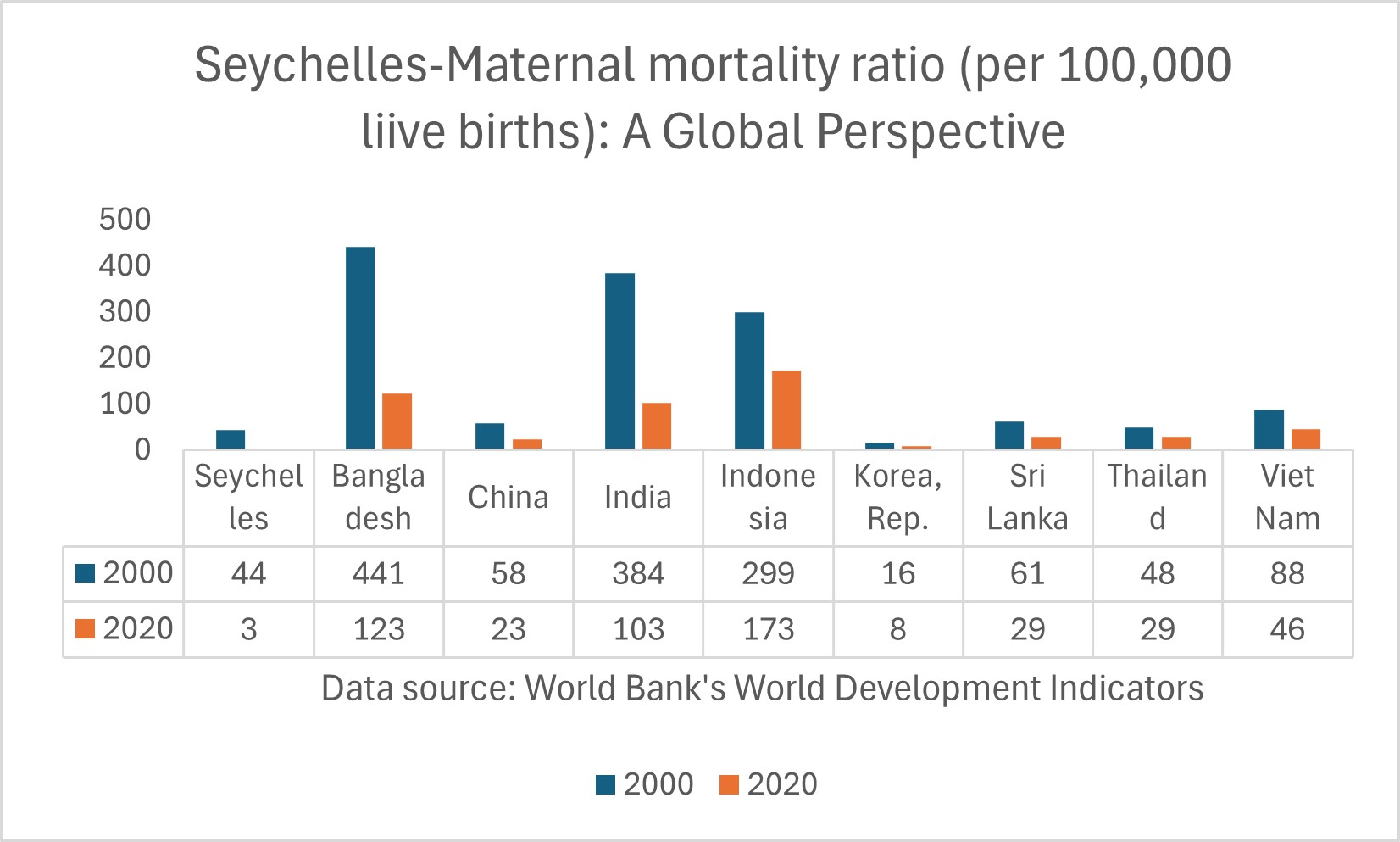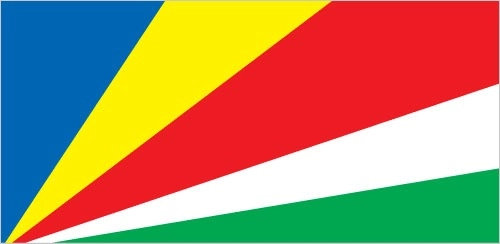
Seychelles
Country Flag Details
five oblique bands of blue (hoist side), yellow, red, white, and green (bottom) radiating from the bottom of the hoist side; the oblique bands are meant to symbolize a dynamic new country moving into the future; blue represents sky and sea, yellow the sun giving light and life, red the peoples’ determination to work for the future in unity and love, white social justice and harmony, and green the land and natural environment.
Background
Seychelles was uninhabited before Europeans discovered the islands early in the 16th century. After a lengthy struggle, France eventually ceded control of the islands to Great Britain in 1814. Seychelles gained independence in 1976.
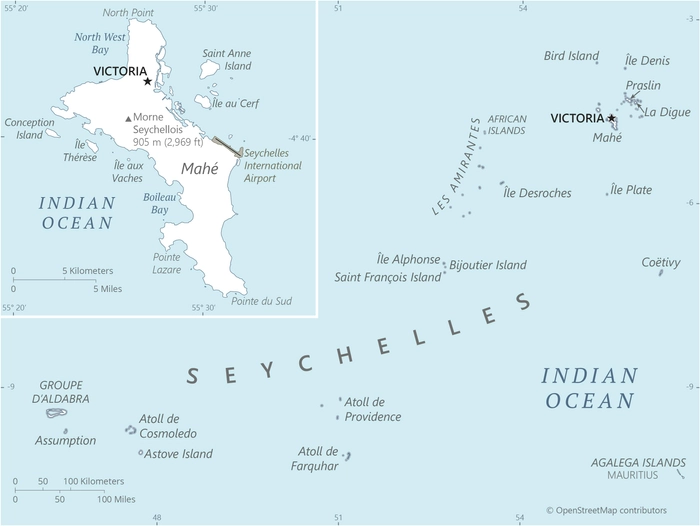
Geography
Area
total : 455 sq km
land: 455 sq km
water: 0 sq km
Climate
tropical marine; humid; cooler season during southeast monsoon (late May to September); warmer season during northwest monsoon (March to May)
Natural resources
fish, coconuts (copra), cinnamon trees
People and Society
Population
total: 98,187
Ethnic groups
predominantly Creole (mainly of East African and Malagasy heritage); also French, Indian, Chinese, and Arab populations
Languages
Seychellois Creole (official) 89.1%, English (official) 5.1%, French (official) 0.7%, other 3.8%, unspecified 1.4% (2010 est.)
Religions
Roman Catholic 76.2%, Protestant 10.5% (Anglican 6.1%, Pentecostal Assembly 1.5%, Seventh Day Adventist 1.2%, other Protestant 1.7%), other Christian 2.4%, Hindu 2.4%, Muslim 1.6%, other non-Christian 1.1%, unspecified 4.8%, none 0.9% (2010 est.)
Population growth rate
0.56% (2024 est.)
Government
Government type
presidential republic
Capital name: Victoria
Executive branch
chief of state: President Wavel RAMKALAWAN (since 26 October 2020)
head of government: President Wavel RAMKALAWAN (since 26 October 2020)
Economy
Economic overview
high-income Indian Ocean island economy; rapidly growing tourism sector; major tuna exporter; offshore financial hub; environmentally fragile and investing in ocean rise mitigation; recently discovered offshore oil potential; successful anticorruption efforts
Real GDP (purchasing power parity)
$3.53 billion (2023 est.)
$3.421 billion (2022 est.)
$2.976 billion (2021 est.)
Real GDP per capita
$29,500 (2023 est.)
$28,500 (2022 est.)
$30,000 (2021 est.)
Exports
$2.375 billion (2023 est.)
$2.247 billion (2022 est.)
$1.751 billion (2021 est.)
Exports – partners
France 20%, Mauritius 12%, UK 9%, Japan 8%, Italy 8% (2023)
Exports – commodities
fish, scrap iron, animal meal, broadcasting equipment, ships (2023)
Imports
$2.437 billion (2023 est.)
$2.298 billion (2022 est.)
$1.821 billion (2021 est.)
Imports – partners
UAE 32%, Spain 10%, France 6%, South Africa 6%, India 6% (2023)
Imports – commodities
refined petroleum, fish, ships, cars, plastic products (2023)

Export structure by product group in 2023 (% of total exports) (UNCTAD)
The export structure of a nation represents the diversity, composition, and value of the goods and services it engages in on the international stage, providing essential insights into the economic health, competitive standing, and developmental status of the country. In the case of Seychelles, the export profile is primarily focused on the fishing sector and petroleum products. A strategic diversification of the export portfolio could significantly bolster economic resilience and mitigate exposure to external market fluctuations.

Poverty and vulnerable employment in Seychelles
Vulnerable employment (no data) is defined as work that lacks adequate job security, offers low wages, and provides insufficient social protections such as health insurance, pensions, or labor rights. This category of employment generally includes own-account workers, who are self-employed without any employees, such as street vendors and small-scale farmers, as well as contributing family workers, who assist in family businesses or farms without receiving formal compensation. Jobs in this realm are often informal and unstable, resulting in a heightened risk of economic shocks, exploitation, and poverty for those involved. The repercussions of such employment extend beyond the individual workforce, affecting families and communities, thereby perpetuating cycles of instability and hardship that can be difficult to overcome.
Understanding poverty level significance at $2.15 per day
In 2018, 0.51 percent of the population in Seychelles (495 people) lived in poverty at $2.15 per day. The poverty level at $2.15 per day (measured in 2017 purchasing power parity, or PPP) is a key global benchmark used by the World Bank to define extreme poverty in low-income countries. It indicates:
1. Basic Survival Threshold
• People living below $2.15 per day struggle to afford essential needs such as food, clean water, shelter, healthcare, and education.
2. Economic Underdevelopment
• A high percentage of a country’s population living below this threshold suggests low economic productivity, high unemployment, and weak social safety nets.
3. Inequality and Social Vulnerability
• It reflects deep income inequality and a lack of access to opportunities for upward mobility.
• People in this category are more vulnerable to shocks like food price increases, climate disasters, or health crises.
4. Policy Challenges
• Governments need targeted interventions such as social welfare programs, job creation, and improved access to education and healthcare to reduce poverty.
A country's export structure is a reflection of its level of development and productive capacities
The export structure of a country refers to the composition, diversity, and value of the goods and services it sells to other countries. It provides key insights into the country’s economic health, competitiveness, and level of development. Productive capacities of a country refer to its ability to produce goods and services efficiently and sustainably over time. These capacities are shaped by various factors, including human capital, natural resources, infrastructure, private sector, development, technology & innovation, institutions & governance, financial systems trade & market access.
Here’s what the export structure and productive capacities of a country typically indicate:
- Level of Economic Development
- Developed economies usually export high-value manufactured goods, technology, and services.
- Developing economies often rely on raw materials, agricultural products, or low-value manufactured goods.
- Industrial and Sectoral Strengths
- A strong presence of high-tech or industrial goods (e.g., machinery, electronics) suggests a well-developed manufacturing sector.
- A dominance of commodities (e.g., oil, minerals, agricultural products) indicates reliance on natural resources.
- Export Diversification
- A diverse export base (multiple industries) makes a country’s economy more stable and resilient to global price shocks.
- A concentrated export base (few key products) makes it vulnerable to market fluctuations.
- Trade Partnerships and Dependence
- If exports are heavily dependent on a single country or region, the economy is more exposed to geopolitical and trade risks.
- A wide range of trading partners indicates stronger global integration.
- Competitiveness and Value Addition
- Exporting mainly raw materials (e.g., crude oil instead of refined petroleum) suggests limited industrial processing capacity.
- A high share of finished and high-tech goods suggests strong value addition and competitiveness.
Seychelles-Sanitation
Seychelles – Proportion of population served with at least basic sanitation
In 2022, proportion of population served with at least basic sanitation for Seychelles was 96.4%. Proportion of population served with at least basic sanitation of Seychelles increased from 95.4 % in 2000 to 96.4 % in 2022 an absolute change of 1 percentage points (pp) between 2000 and 2022..
Seychelles – Proportion of population served with at least basic water
In 2022, proportion of population served with at least basic water for Seychelles was 96.4 %. Proportion of population served with at least basic water of Seychelles increased from 93.9 % in 2000 to 96.4% in 2022 an absolute change of +2.5
Seychelles- Proportion of population with access to electricity
In 2022, proportion of population with access to electricity was 100% . Proportion of population with access to electricity of Seychelles increased from 94.1 % in 2000 to 100 % in 2022 an absolute change of +5.9
Seychelles- Proportion of population not served with at least basic drinking water: A Global Perspective
The lack of access to safe drinking water and adequate sanitation facilities continues to be a pressing global concern, resulting in the heartbreaking loss of hundreds of thousands of lives every year due to unsafe sanitation practices. Access to proper sanitation is not merely a basic human need; it is widely recognized as an essential human right that every individual deserves. Alarmingly, as of 2022, nearly 5,000 people, which constitutes about 4% of the total population in Seychelles, were reported to lack access to safe drinking water. This figure starkly contrasts with other regions, such as Vietnam, where only 1% of the population faces similar challenges, and the global average stands at 6%. These statistics underscore the urgent need for enhanced sanitation infrastructure in Seychelles, and uphold the fundamental human rights of all individuals.
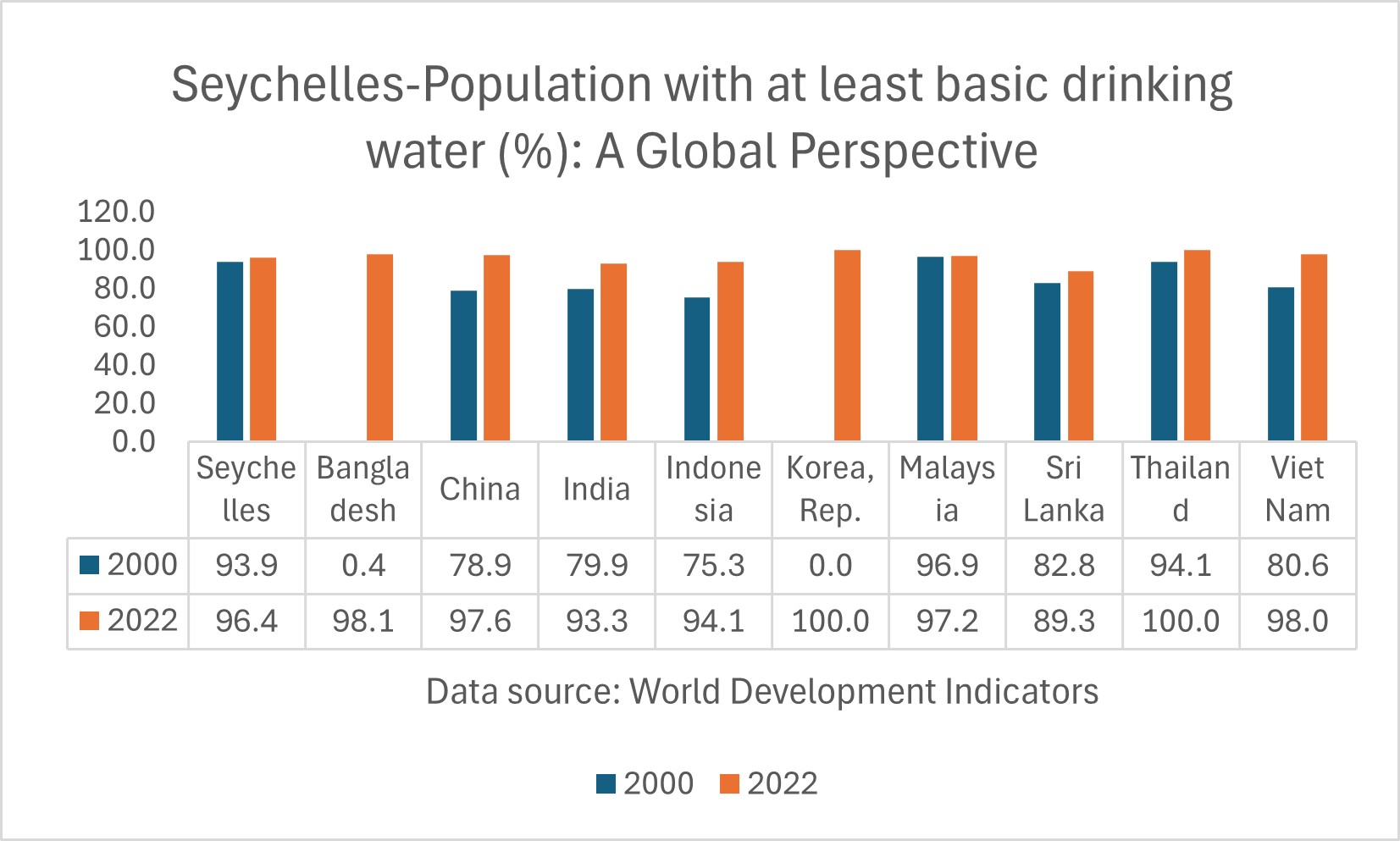
Seychelles – Proportion of population not served with at least basic sanitation: A Global Perspective
Seychelles distinguishes itself in the area of basic sanitation, showcasing impressive figures that highlight the percentage of its population utilizing essential sanitation facilities in comparison to other countries across Asia. As a remarkable exception within Sub-Saharan Africa, Seychelles celebrated an extraordinary achievement in 2022 by providing 100 percent of its population with access to basic sanitation facilities. This significant milestone not only emphasizes the country’s commitment to public health but also sets a benchmark for other nations in the region. In addition, countries like South Korea and China have also made considerable strides, with 1percent of their populations lacking from at least basic sanitation services in the same year, reflecting a broader global effort to enhance sanitation standards and improve the quality of life for millions.
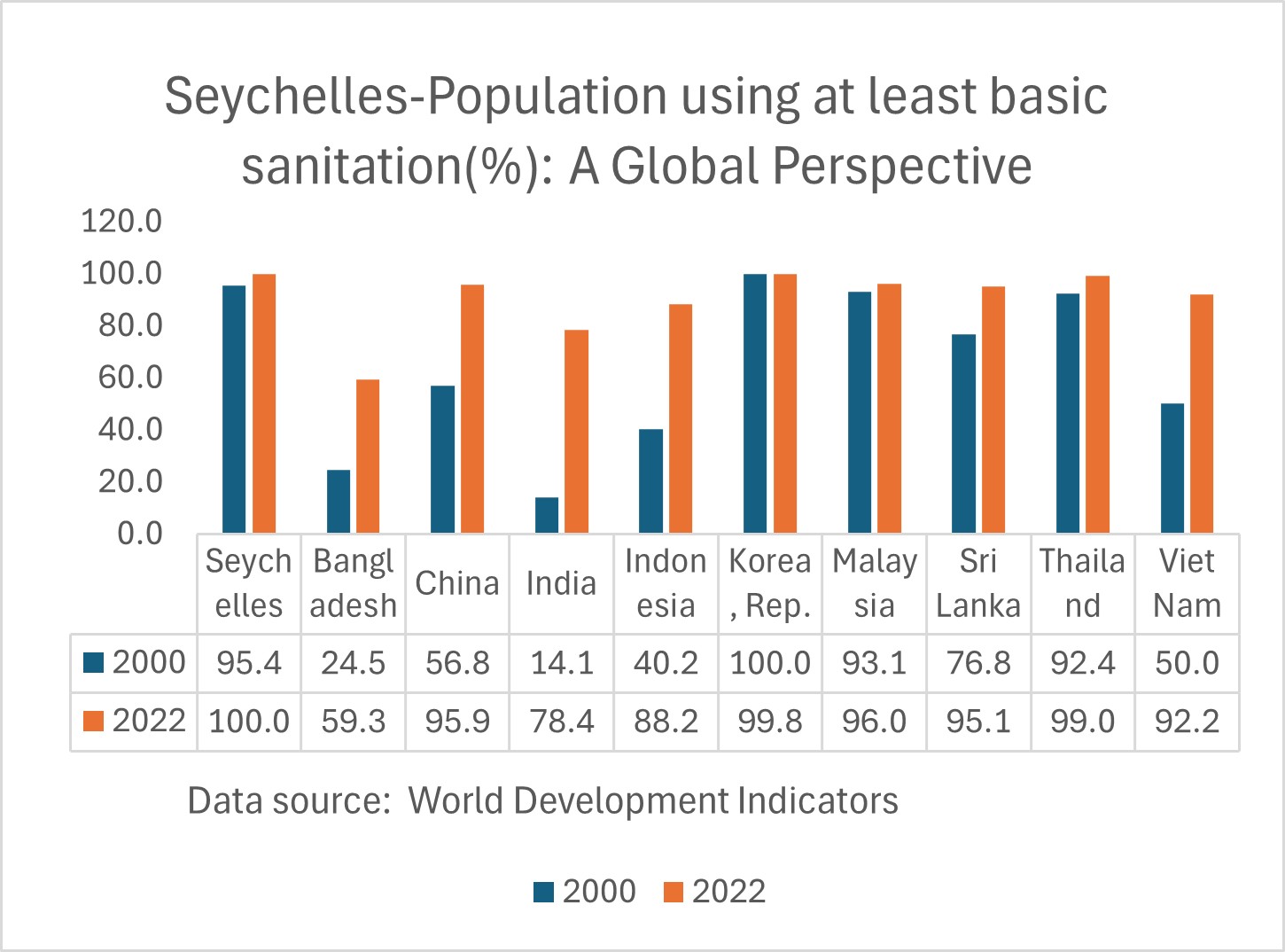
Seychelles: Health outcomes
Seychelles-Life expectancy: A Global Perspective
Over the past seven decades, the rise in global life expectancy stands as a compelling testament to the improvements in health care and living conditions across the world, marking a profound advancement in human longevity. For instance, in 1950, the average life expectancy at birth was a mere 47 years; however, by 2021, this number had increased significantly to reach 71 years. In contrast to many countries in Sub-Saharan Africa, Seychelles has made notable strides, with life expectancy increasing from 69 years in 1980 to 74 years by 2022, reflecting a commitment to enhancing public health. Similarly, South Korea has seen a remarkable transformation, with life expectancy skyrocketing from just 21 years in 1950 to an impressive 84 years in 2021, showcasing the impact of progressive policies and health initiatives. The Maldives has also achieved considerable improvements, with life expectancy rising from 39 years in 1960 to 81 years in 2022, demonstrating similar trends of healthcare advancements and socioeconomic development that resonate globally.
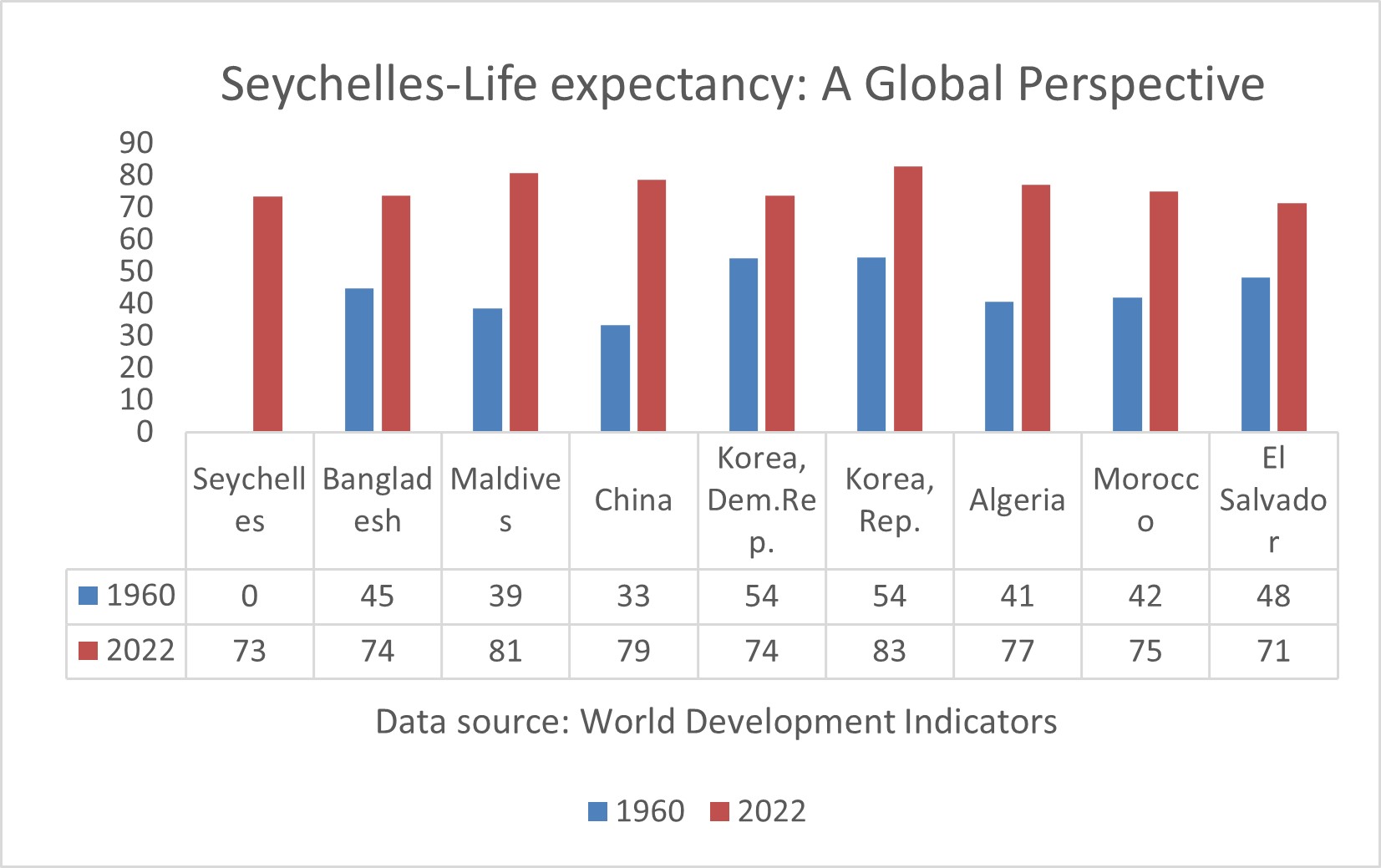
Since 1950, there has been a remarkable global decline in child mortality rates, a positive trend attributed to advancements in living standards, improvements in healthcare, better nutrition, and increased access to safe drinking water. In the wealthiest nations of Europe and America, child mortality has plummeted to less than four percent, reflecting the successful implementation of various health initiatives. Over the past 70 years, numerous developing countries across South America, Asia, and Africa have also made significant strides in reducing child mortality rates. Notably, Seychelles shines as a country within Sub-Saharan Africa, boasting particularly low child mortality figures. The under-five mortality rate in Seychelles has impressively decreased from 30 per 1,000 live births in 1980 to just 14 in 2022. This achievement becomes even more striking when compared to other nations such as South Korea, Sri Lanka, and Thailand, where the under-five mortality rates were recorded at three, seven, and eight, respectively, in 2022, highlighting the progress made by Seychelles in the context of broader regional challenges.

In the following statistics, we analyze the annual rates of pregnancy-related deaths across various regions and countries, highlighting the concerning fact that a large portion of these fatalities occurs in Sub-Saharan Africa, where maternal health challenges are particularly severe. This troubling pattern is largely due to the region’s high birth rates and significantly elevated maternal mortality rates impacting many communities, which point to longstanding healthcare disparities. Notably, Seychelles emerges as an exception in Sub-Saharan Africa, exhibiting a remarkable reduction in its maternal mortality ratio from 44 in 2000 to just 3 in 2022, showcasing the success of comprehensive healthcare initiatives and targeted interventions in enhancing maternal health outcomes. Additionally, nations such as South Korea and China have also made noteworthy progress in maternal health, with their maternal mortality rates declining from 16 to 3 and from 58 to 23, respectively, between 2000 and 2022, reflecting substantial improvements in healthcare infrastructure and increased access to vital medical services for women, thus fostering a safer and healthier environment for both mothers and their newborns.
